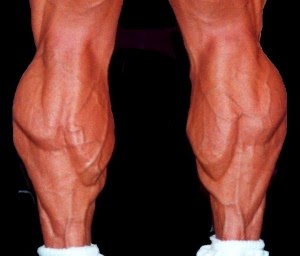One way that the calf-deficient like to train is using the shock-and-awe method – one session dedicated to punishing the gastrocs unmerciful. Well, if that’s not working, you may want to consider a more indirect approach.
“Don’t work your calves with straight sets,” says Ryno. “Instead, perform your calf exercises between sets of other exercises. This allows you to actively rest them and allows you to have more strength and lift heavier weight during each set.”
2. STRECH ‘EM!
It’s common knowledge that is quickly forgotten when the burn starts to set in: a muscle that is stretched well contracts stronger. That’s why a full range of motion is important, even on calf day. But that’s not the only time that you can benefit from calf stretches.
“Stretching your calves before, during and after your workout will increase blood flow to the target muscle as well as aid in the overall development of the gastroc, soleus, and tibialis anterior.”
3. VARIETY COUNTS
Even if you are one of the lucky few that finds a calf routine that helps you inflate those peg legs, you will
eventually hit a plateau. This is why it’s recommended that you change your routine – no matter the bodypart – every 4-8 weeks. But the calves may respond well to even more variety.
“Do not perform the same exercises each and every workout,” Ryno cautions. “Change them up periodically as growth stalls when constantly performing the same exercises in the same fashion. For example, use single-leg variations, toes in and toes out positioning, gatroc-focused (straight-leg) one day and soleus (bent leg) the next. The body adapts well to constant change and this can be even more applicable with the calves.”
4. GO PLYO
Point toes, rest, repeat. This is a great, albeit very vanilla way to target the calves but getting a bit more dynamic may provide the push that they need to really get growing.
“Incorporate plyometric moves into your program that are sprint-specific,” says Ryno. “Bounding, linear jumps, plyo step-ups, lateral jumps…all of these really work the calves explosively.”
5. LOSE THE SHOES
“When performing your calf exercises barefoot it forces your calves to do more work, allows you to go through a greater range of motion, and also gives you a better ‘grip’ when using heavier weight,” says Ryno.
If nothing else, it provides variety and forces your foot and calf to work in unfamiliar ways – a surefire formula for greater growth.

